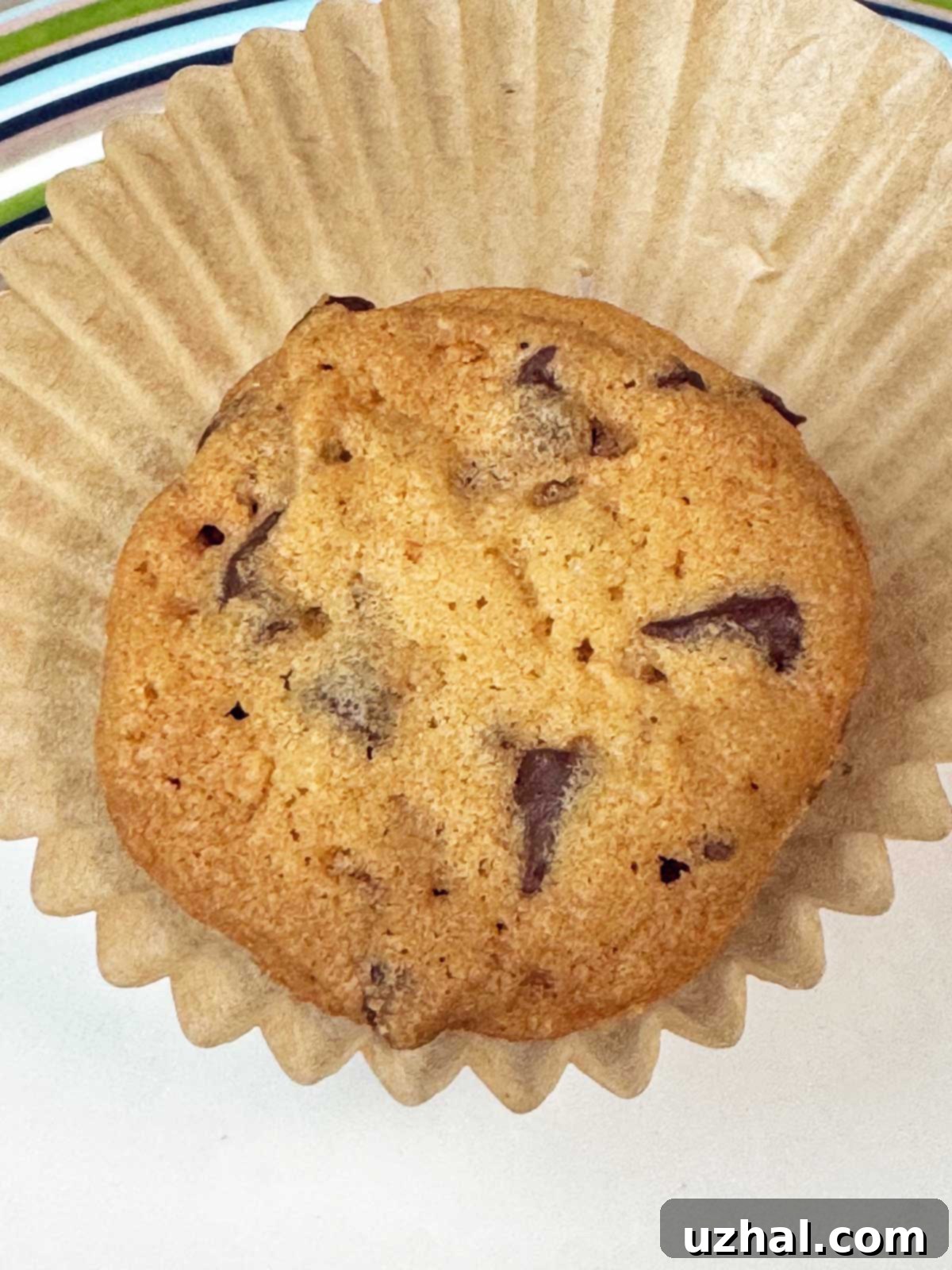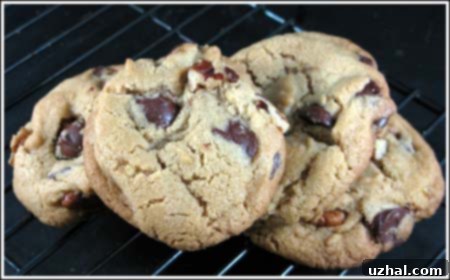The Ultimate Guide to Perfectly Crunchy Chocolate Chip Cookies: A Trusted Small Batch Recipe
There’s a special joy in biting into a chocolate chip cookie that delivers a satisfying crunch from edge to center. If you’ve been on a quest for that elusive, store-bought-quality crispness in your homemade treats, your search ends here. This isn’t just another chocolate chip cookie recipe; it’s a meticulously developed, time-tested method for achieving consistently crunchy results. Originally inspired by a King Arthur Flour recipe, it has evolved over the years into a staple in many kitchens, perfected for maximum crispiness.
The Secret to Unwavering Crispness: Ingredient Ratios and Precision
What sets this recipe apart, and indeed what is absolutely crucial for achieving its signature crunch, is the precise balance of ingredients. Specifically, we employ a strategic blend of half shortening and half butter. This combination harnesses the best qualities of both fats: butter provides unparalleled flavor and contributes to a beautiful golden-brown color, while shortening, being 100% fat and having a higher melting point, helps to limit spread and promote that desired crispy texture. Moreover, for truly consistent results, we highly recommend weighing your ingredients. Baking is, after all, a science, and even the smallest deviation in ingredient ratios can significantly alter the final texture of your chocolate chip cookies.
Beyond the primary fats, several other factors play a pivotal role in the outcome. The brand of flour you use, the moisture content of your brown sugar, the extent of the creaming process, and even the type of baking sheets can all influence the cookie’s texture. For instance, flours with higher protein content can lead to chewier cookies, while a dryer brown sugar might yield a crisper result. This is why baking often involves a bit of experimentation. This particular recipe is designed as a relatively small batch, making it ideal for testing and fine-tuning to your specific oven and preferences. Remember, the ultimate goal here is uncompromising crunch, not soft and chewy.
Emulating Bakery Favorites: Crunchy Mini Cookies Like Trader Joe’s
For those who adore the delicate, crisp bite of miniature chocolate chip cookies, akin to the beloved little ones from Trader Joe’s, this recipe offers a fantastic variation. You’ll find detailed notes on how to adapt the recipe for smaller, crispier cookies, and the comments section is a treasure trove of shared experiences. It’s truly heartwarming to discover that many home bakers aspire to replicate that light, crisp texture found in commercial mini cookies. While these might not be an exact replica, they come remarkably close, offering a delightful crunch in a smaller format perfect for snacking or sharing.
Exploring Baker’s Ammonia for Enhanced Crispness and Air Pockets
For the truly adventurous baker seeking to maximize crispness and achieve an airy, delicate crumb, incorporating baker’s ammonia (also known as ammonium carbonate) is a fascinating technique. We owe a debt of gratitude to Sugardoll, whose detailed experimental notes (shared in the comments) highlight the successful substitution of the traditional baking soda and vinegar mixture. Sugardoll found that replacing the baking soda and vinegar with just ½ teaspoon of ammonium carbonate, dissolved in a tiny bit of water and baked at 325°F for 18 minutes, yielded remarkably crisp cookies with an abundance of air pockets.
Upon testing this method, the results were indeed impressive: cookies with an undeniable crispness and a distinctive, light structure. It appears that using the whisk attachment of a stand mixer to thoroughly beat air into the creamed butter and sugar mixture, combined with the dissolved baker’s ammonia, significantly contributes to this unique texture. Baker’s ammonia is a leavening agent that was historically used in cookies and crackers to create a very open, crisp texture. Unlike baking soda or powder, it evaporates completely during baking, leaving no residual flavor or alkalinity, which makes it ideal for achieving a super crisp cookie. If you’re looking to push the boundaries of cookie crunch, this is a modification well worth exploring.

This tried-and-true recipe, adapted from the invaluable The King Arthur Cookie Companion, promises to become your go-to for those moments when only a truly crunchy chocolate chip cookie will do. Its small batch size also makes it perfect for experimenting with the subtle nuances that create the perfect texture.
Recipe: Classic Crunchy Chocolate Chip Cookies (Small Batch)

Crunchy Chocolate Chip Cookies — Small Batch
Anna
Pin Recipe
Ingredients
- 4 tablespoons unsalted butter unsalted, room temp (56 grams) – for rich flavor and color
- 4 tablespoons shortening (48 grams) – crucial for crispness and minimal spread
- ½ cup brown sugar very firmly packed — mixture of light and dark (110 grams) – provides moisture and a slight chewiness, but less than an all-brown sugar recipe
- ¼ cup granulated sugar (48 grams) – contributes to spread and overall crispness
- 1 teaspoon vanilla extract – enhances the overall flavor profile
- ⅜ teaspoon salt – balances sweetness and highlights chocolate flavor
- ½ tablespoon apple cider or white vinegar – reacts with baking soda for leavening and crispness
- 1 ½ tablespoons lightly beaten egg (18 grams) – precise measurement is key for texture
- ½ teaspoon baking soda – primary leavening agent for spread and texture
- 1 cup King Arthur all-purpose flour* (128 grams) – for optimal structure and crispness
- 1 ½ cups semisweet chips or mini chips if making tiny cookies – your preferred chocolate for delightful pockets of sweetness
- Some toasted pecans handful, optional** – adds a delightful nutty crunch
Instructions
-
Preheat your oven to a consistent 350°F (175°C). Ensure you have ungreased cookie sheets ready for baking. The ungreased surface helps promote crisping.
-
In a large mixing bowl, using an electric mixer, cream together the room temperature unsalted butter, shortening, brown sugar, and granulated sugar. Beat on medium-high speed until the mixture is light, pale, and thoroughly fluffy. This creaming process incorporates air, which is vital for the cookie’s final texture. Next, beat in the vanilla extract, salt, and vinegar until just combined. Stop the mixer, scrape down the sides of the bowl with a spatula, then add the precisely measured beaten egg. Continue beating until the egg is fully incorporated and the mixture is smooth. Finally, add the baking soda and beat briefly to ensure it is evenly distributed throughout the dough. With the mixer on low speed, gradually add the King Arthur all-purpose flour, mixing until just combined. Be careful not to over-beat the dough once the flour is added, as overmixing can develop gluten and lead to tougher cookies. Gently stir in the chocolate chips and any optional toasted nuts by hand.
-
Using a tablespoon or a small cookie scoop (approximately 1 tablespoon in size), drop rounded portions of dough onto the prepared ungreased cookie sheets, leaving ample space between each cookie for spreading. Bake for 10-14 minutes, or until the edges are golden brown and crisp, and the centers are set. Baking time may vary depending on your oven and the size of your cookies. Once baked, remove the cookie sheets from the oven and let the cookies cool on the sheet for approximately 2-3 minutes. This crucial step allows them to set further and helps prevent them from breaking. Then, carefully transfer the cookies to a wire rack to cool completely, ensuring maximum crispness.
-
If you prefer to bake your cookies at a later time, you can prepare the dough in advance. Scoop the dough into 1-tablespoon portions and arrange them on a dinner plate or small baking sheet lined with parchment paper. Cover the plate tightly with plastic wrap and chill the dough in the refrigerator until you are ready to bake. Chilled dough can result in a slightly thicker, chewier cookie, but still wonderfully crunchy on the edges if baked correctly.
Mini Cookies Using 325F.
-
To achieve those delightful mini crunchy cookies, take each 1-tablespoon scoop of dough and divide it into 3 or 4 even smaller portions. Roll these smaller portions into tiny, marble-sized balls. Gently press down on each ball with the palm of your hand or the bottom of a glass to slightly flatten them before baking. This helps with even baking and crisping. Bake these mini cookies at a slightly lower temperature of 325°F (160°C). The exact baking time may vary, so start checking them at 15 minutes. Continue baking until they are golden brown and crisp throughout. This lower, slower baking method helps them dry out and become crisp without burning the delicate edges.
Notes
While you can use any brand of all-purpose flour, we’ve found that King Arthur’s all-purpose flour consistently yields excellent results for these crunchy cookies. Its protein content and consistency contribute to the desired texture.
The precise amount of egg is more critical in this recipe than in many others, as it directly impacts the final texture. To ensure you use exactly 1 ½ tablespoons of egg, crack a large egg into a small bowl, whisk it lightly with a fork until yolk and white are just combined, then measure out 1 ½ tablespoons. If you have a kitchen scale, measuring approximately 18 grams of beaten egg is even more accurate.
VARIATION: For truly miniature cookies that rival your favorite store-bought varieties, spoon the dough into 22 equal 1-tablespoon portions. Then, take each of these portions and divide it further into 3 small sections. Roll these sections into tiny, marble-sized balls. Bake these mini cookies at a lower temperature of 300°F (150°C) for 15 to 18 minutes. This gentle, low-and-slow baking method helps the cookies dry out and crisp up thoroughly before the edges can burn. Alternatively, you can try baking them at 325°F (160°C) for a slightly more pronounced caramelization and browning. Keep in mind that oven temperatures can vary significantly, so it’s always a good idea to test a small batch first to determine the perfect low and slow bake time for your specific oven to achieve maximum crispness without over-browning.
Advanced Tips for the Ultimate Crunchy Chocolate Chip Experience
Achieving truly exceptional crunchy chocolate chip cookies is both an art and a science. Beyond the core recipe, several nuanced details can elevate your baking. Consider the consistency of your brown sugar; if it’s very dry, it might absorb too much moisture from other ingredients, leading to a brittle cookie. Conversely, overly moist brown sugar could result in a chewier texture. Storing brown sugar with a slice of bread or a marshmallow can help maintain ideal moisture levels. For best results, always measure flour by weighing it, as scooping can pack it down and lead to too much flour, which makes for a dry, crumbly cookie rather than a perfectly crisp one.
The type of baking sheet you use can also influence crispness. Lighter colored, heavy-gauge aluminum baking sheets tend to distribute heat more evenly and prevent over-browning of the bottoms, promoting a more uniform crisp. Darker sheets absorb more heat and can lead to darker, crisper edges but potentially burnt bottoms if not monitored closely. Experiment with what works best in your oven. Cooling is another often-underestimated step. Allowing cookies to cool completely on a wire rack ensures air circulation around all sides, preventing steam from softening them and locking in that desired crunch. Stacking warm cookies can trap moisture and ruin their crisp texture.
Troubleshooting Common Crunchy Cookie Challenges
Even with a reliable recipe, challenges can arise. If your cookies aren’t as crunchy as you’d hoped, consider these common culprits:
- Too much moisture: This could be from too much brown sugar, an oversized egg, or even high humidity in your kitchen. Ensure brown sugar is firmly packed but not rock-hard. Precision in egg measurement (using a scale for grams if possible) is crucial.
- Underbaking: Cookies need sufficient time in the oven for moisture to evaporate. If they’re too pale, they’re likely not dry enough to be truly crunchy. Extend baking time by a minute or two until golden.
- Oven temperature variations: An inaccurate oven can significantly impact results. An oven thermometer is an inexpensive tool that can save many batches of cookies. Too low a temperature means slow evaporation and potentially chewier cookies, while too high can burn the edges before the center is cooked through.
- Overmixing the flour: Developing too much gluten in the flour can lead to tougher, less crisp cookies. Mix just until the flour streaks disappear.
- Storing incorrectly: Store crunchy cookies in an airtight container at room temperature. If they become soft over time, you can often re-crisp them by baking for a few minutes at a low temperature (around 250°F/120°C).
Ultimately, baking is a journey of discovery. Don’t be discouraged if your first batch isn’t perfect. Each attempt refines your technique and understanding of how ingredients interact. This small batch recipe provides an excellent foundation for mastering the art of the crunchy chocolate chip cookie.
We invite you to try this recipe and discover the pure delight of a perfectly crunchy, deeply flavorful chocolate chip cookie. Whether you stick to the classic method or venture into the realm of baker’s ammonia, you’re sure to create a batch that satisfies your craving for that unmistakable crisp snap. Happy baking!
